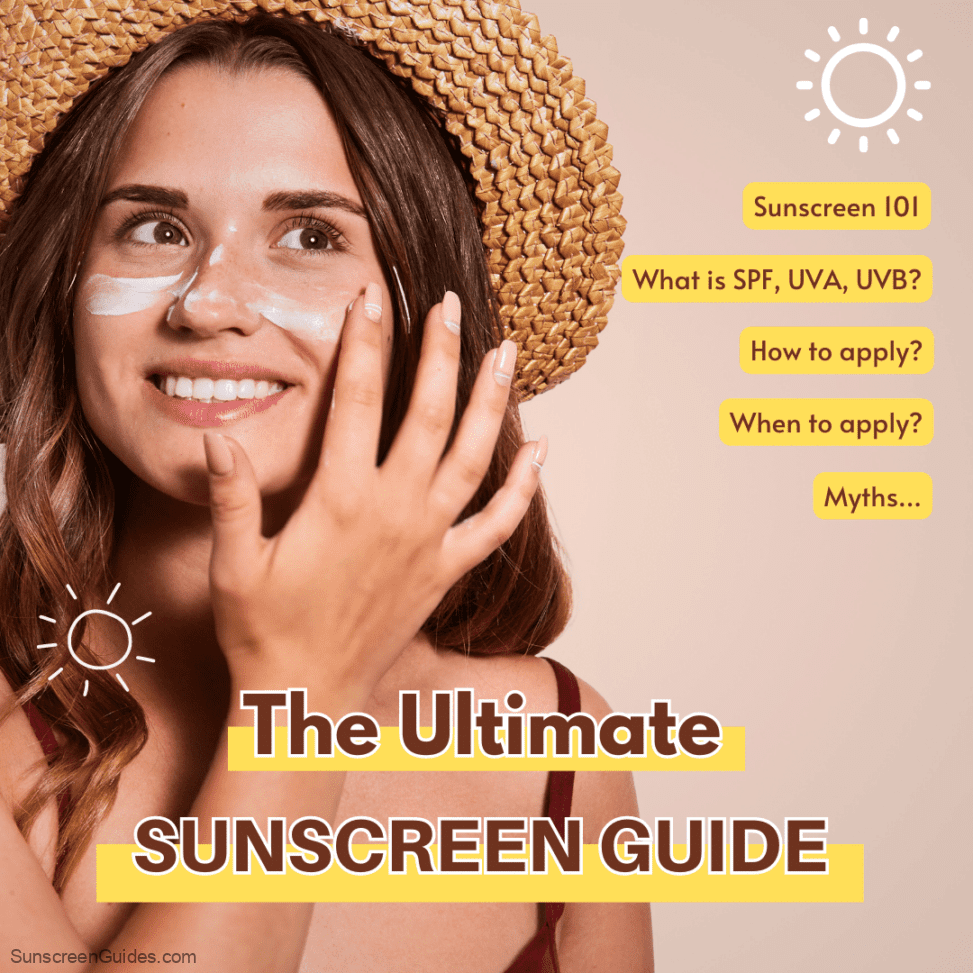Hey there, sun-savvy beauties! Are you ready to embark on an epic adventure through the world of sunscreen? Buckle up and grab your floppy hats because we’re about to dive into Sunscreen 101 / Sunscreen Guide! Whether you’re a sunscreen newbie or a seasoned pro, this guide will equip you with all the knowledge and tricks you need to conquer the mighty sun and keep your skin looking as radiant as ever. Let’s get started!
Table of Contents
1) Unmasking the Sunscreen Superheroes
Picture this: You’re strolling down the sunscreen aisle, and suddenly you’re faced with an army of SPF warriors, each promising to be the ultimate shield against the sun’s wrath. Fear not, my dear readers! In this section, we’ll decode the sunscreen jargon, demystify SPF numbers, and reveal the secret identities of UVA and UVB rays. It’s time to unmask the sunscreen superheroes and understand how they battle those sneaky sunbeams!
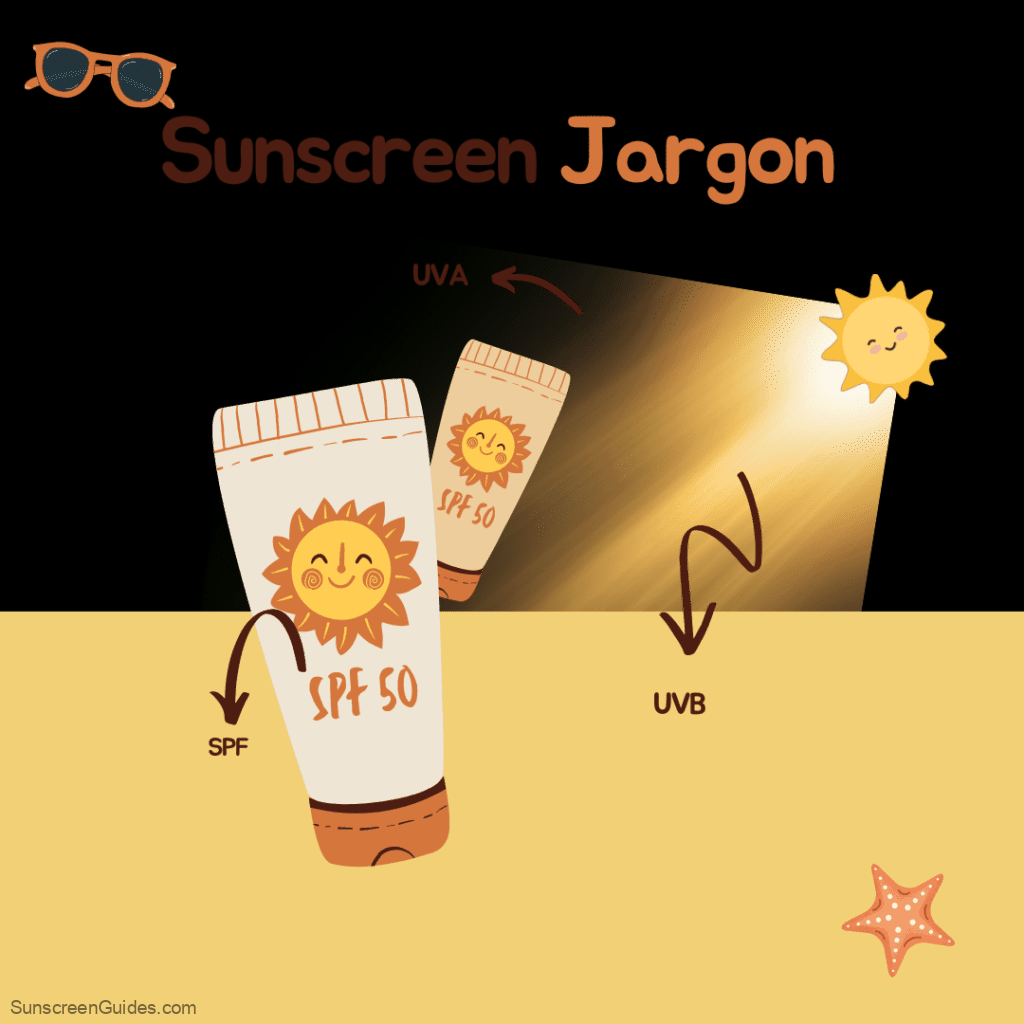
Decoding the Sunscreen Jargon: SPF, UVA, UVB, OH MY!
Have you ever felt lost in a sea of acronyms and scientific terms when it comes to sunscreen? Well, fret no more! Let’s break it down in simple, everyday language:
- SPF: Short for Sun Protection Factor, this is the numerical value that indicates a sunscreen’s ability to block UVB rays. The higher the SPF number, the longer you can stay in the sun without getting sunburned. But remember, SPF isn’t everything!
- UVA: The “A” stands for Aging, and these sneaky rays can penetrate deep into the skin, causing premature wrinkles, fine lines, and other signs of aging. UVA rays are present year-round, even on cloudy days, so protecting yourself from them is crucial.
- UVB: The “B” stands for Burning, and these rays are responsible for those painful sunburns. UVB rays are strongest between 10 am and 4 pm, so be extra vigilant during those hours.
Sunscreen Guide SPF Numbers: Size Does Matter (Kind of)
Now that we know what SPF stands for, let’s talk numbers! Many of us have fallen into the SPF number trap, thinking that higher is always better. But hold your horses, my friends! The truth is, the difference between SPF 30 and SPF 50 is not as drastic as you might think.
- SPF 30: This is the most common recommendation from dermatologists. It blocks about 97% of UVB rays, allowing you to stay in the sun 30 times longer than you would without any protection. Not too shabby, right?
- SPF 50: It’s the superstar of the sunscreen world, blocking around 98% of UVB rays. But here’s the catch: SPF 50 doesn’t mean you can spend twice as long in the sun compared to SPF 25. The extra protection is minimal, so don’t be fooled into thinking you’re invincible!
Remember, regardless of the SPF number, according to Sunscreen Guide best practices you still need to reapply sunscreen every two hours, especially after swimming or sweating.
UVA and UVB: The Dynamic Duo of Sun Protection
Think of UVA and UVB rays as the notorious villains of the sun world. UVA rays silently age your skin while UVB rays relentlessly burn it. But fear not, for your sunscreen superheroes are here to save the day!
- Broad-Spectrum Protection: Look for sunscreens labeled “broad-spectrum,” as they offer protection against both UVA and UVB rays. This dynamic duo will shield you from premature aging, sunburns, and all the other dastardly effects of the sun.
- SPF 15+: Always opt for sunscreens with an SPF of 15 or higher to ensure adequate UVB protection. But don’t forget, UVA protection is just as important, so make sure it’s labeled as broad-spectrum too.
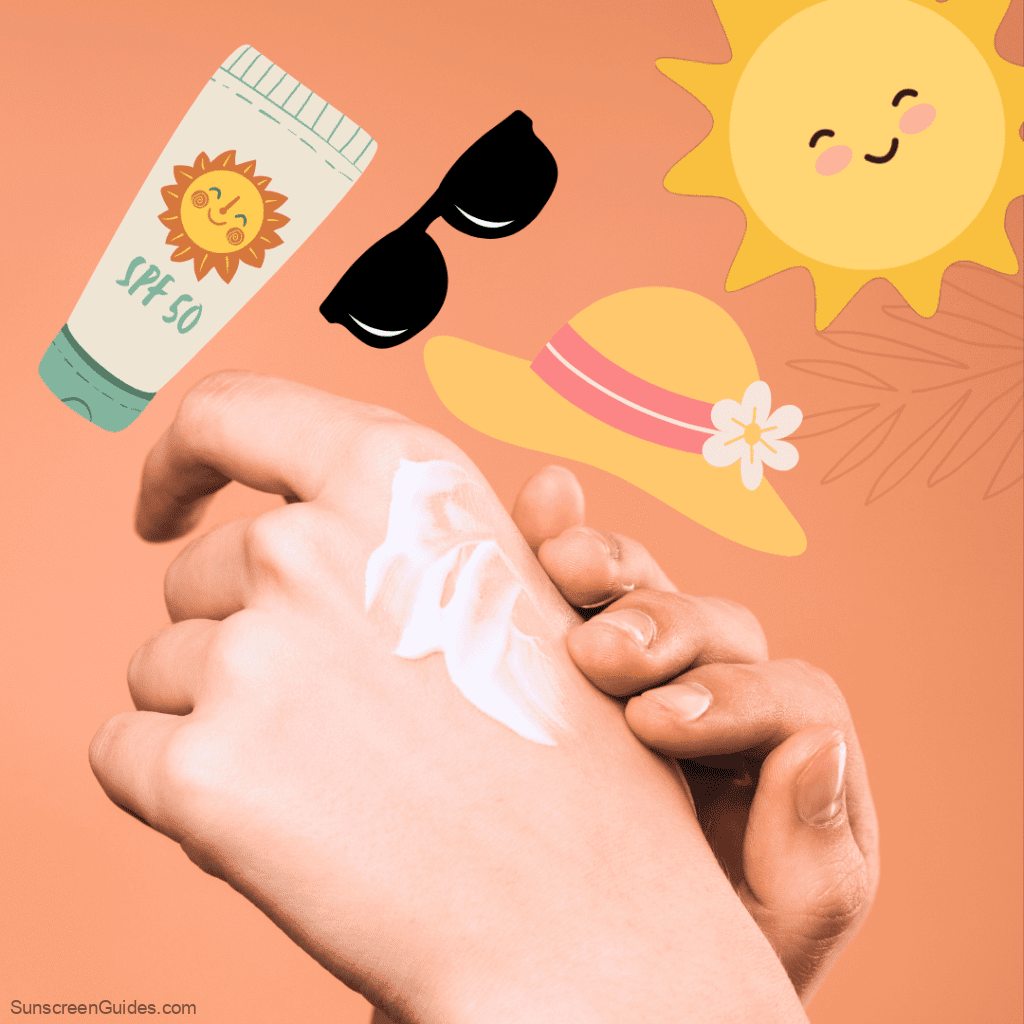
Sunscreen Enhancements: Water Resistance and Beyond
In the quest for optimal sun protection, keep an eye out for some extra superpowers that sunscreens might possess:
- Water Resistance: If you’re planning to take a dip in the ocean or pool, water-resistant sunscreens can be a game-changer. They provide some degree of protection even when you’re splashing around or sweating up a storm. Just remember to reapply after toweling off!
- Sweat-Proof Formulations: For those intense workout sessions or outdoor adventures, sweat-proof sunscreens are a must-have. They’re designed to stay put even during your sweatiest moments, keeping you protected and confident.
- Non-Comedogenic: If you have acne-prone or sensitive skin, look for sunscreens labeled as non-comedogenic. These formulations won’t clog your pores or cause unwanted breakouts, allowing you to enjoy the sun without worrying about blemishes.
Armed with this knowledge, you’re ready to choose the right sunscreen for your adventures under the sun. Stay tuned for the next section, where we’ll dive into the exciting realm of sunscreen application techniques. Until then, keep calm and slather on that SPF!
2) Sunscreen Guide Application: A Smoothing Ritual
Applying sunscreen can be an art form, my friends. From the classic “ghost face” to the notorious “missed spot” blunders, we’ve all been there. But worry not! I’ll share my tried-and-true techniques to ensure a flawless application every time. Get ready to dance the sunscreen tango and master the art of blending, dabbing, and slathering sunscreen like a pro!
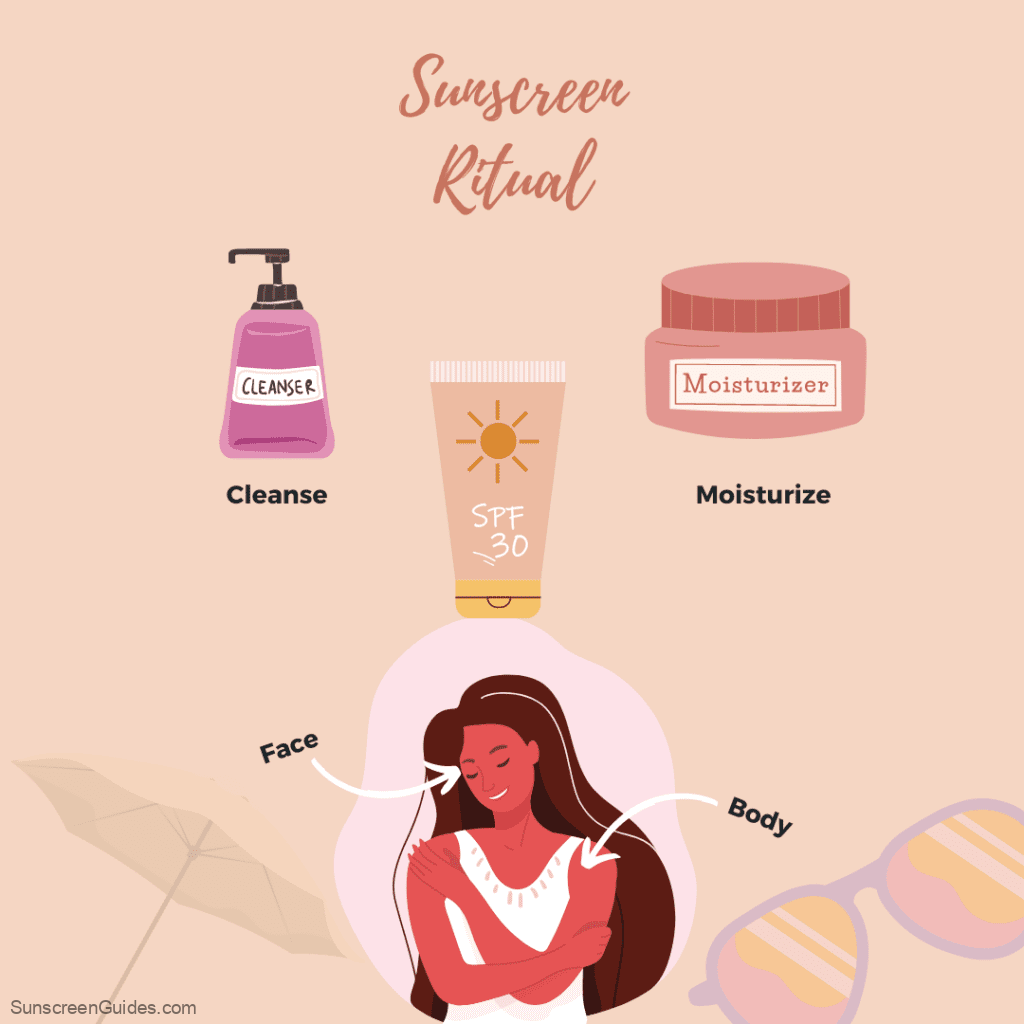
Prep and Prime: Preparing Your Canvas
Before we dive into the world of sunscreen application, let’s ensure your canvas is ready for the masterpiece. Follow these prepping steps for the ultimate sun protection experience:
- Cleanse: Start with a clean face. Gently cleanse your skin with a mild cleanser to remove any dirt, oil, or remnants of your previous skincare routine.
- Moisturize: Hydrated skin is happy skin! Apply a lightweight moisturizer suitable for your skin type. This step will provide a smooth base for your sunscreen and help lock in moisture throughout the day.
Sunscreen Guide Perfect Dose: Quantity Matters
Here’s a little secret: sunscreen is not a place to skimp. You need an ample amount to ensure proper coverage and protection. Say goodbye to those measly pea-sized amounts! Follow these guidelines for the perfect dose:
- Face: Aim for a quarter-sized amount (yes, you read that right!) for your face and neck. Don’t forget to extend it down to your décolletage if exposed.
- Body: For the body, as a general rule, use about one ounce (that’s a shot glass full!) to cover all exposed areas. If you’re rocking that itty-bitty bikini, don’t forget the nooks and crannies!
The Art of Blending: Dance the Sunscreen Tango
Now that you have the right amount, it’s time to work your magic and blend that sunscreen in like a pro. Follow these steps for a seamless application:
- Sunscreen Guide Face: Start by dotting the sunscreen on different areas of your face – cheeks, forehead, nose, and chin. Gently massage the product into your skin using upward and outward motions. Take your time and ensure even coverage, paying extra attention to your hairline and jawline.
- Sunscreen Guide Body: Begin with one body part at a time. Apply the sunscreen using smooth, circular motions. Don’t forget those easily forgotten areas like the back of your neck, tops of your feet, and behind your knees. Enlist the help of a partner or reach those tricky spots with a long-handled applicator for a flawless finish.
Don’t Miss a Spot: Mind the Gap!
Even the most skilled sunscreen appliers can fall victim to the notorious “missed spot” blunders. To avoid embarrassment and sunburn surprises, keep these often overlooked areas in mind:
- Ears: Those delicate ears need love too! Apply sunscreen to every nook and cranny, paying attention to the tops, lobes, and even the backs of your ears.
- Lips: Your luscious lips deserve protection as well. Choose a lip balm or lipstick with SPF and apply generously throughout the day. Pucker up, buttercup!
- Hairline: The sun’s rays can be sneaky and find their way to your scalp. If your hairline is exposed, create a barrier by running some sunscreen along the edge of your hairline, blending it in gently.
Touch-Up Time: Reapply and Stay Protected
Remember, sunscreen guide isn’t a one-and-done deal. It needs a little love and attention throughout the day. Follow these touch-up tips to ensure continuous protection:
- Time It Right: Reapply sunscreen every two hours, especially if you’re spending prolonged periods in the sun or if you’ve been sweating or swimming.
- Easy Does It: Avoid rubbing off your carefully applied makeup by opting for sunscreen sprays or powder formulations for touch-ups. Lightly mist or dust them over your face for a quick refresher.
You’ve mastered the art of sunscreen guide application and turned it into a smoothing ritual. From prepping your canvas to blending with finesse, your skin is now ready to conquer the sun’s rays with confidence. Stay tuned for the next section, where we’ll explore the enchanted world of finding the perfect sunscreen for your unique skin needs. Until then, keep dancing the sunscreen tango and keep that beautiful canvas protected!
3) The Sunscreen Chronicles: Finding “The One”
Ah, the quest for the perfect sunscreen. It’s like searching for a unicorn that also doubles as a fairy godmother. But fear not, fair maidens! I’ll guide you through the maze of formulations, textures, and finishes to help you find your soulmate sunscreen. Matte or dewy? Chemical or mineral? We’ll explore the magical world of sun protection and help you discover “The One” that suits your skin type and leaves you feeling like a million bucks.
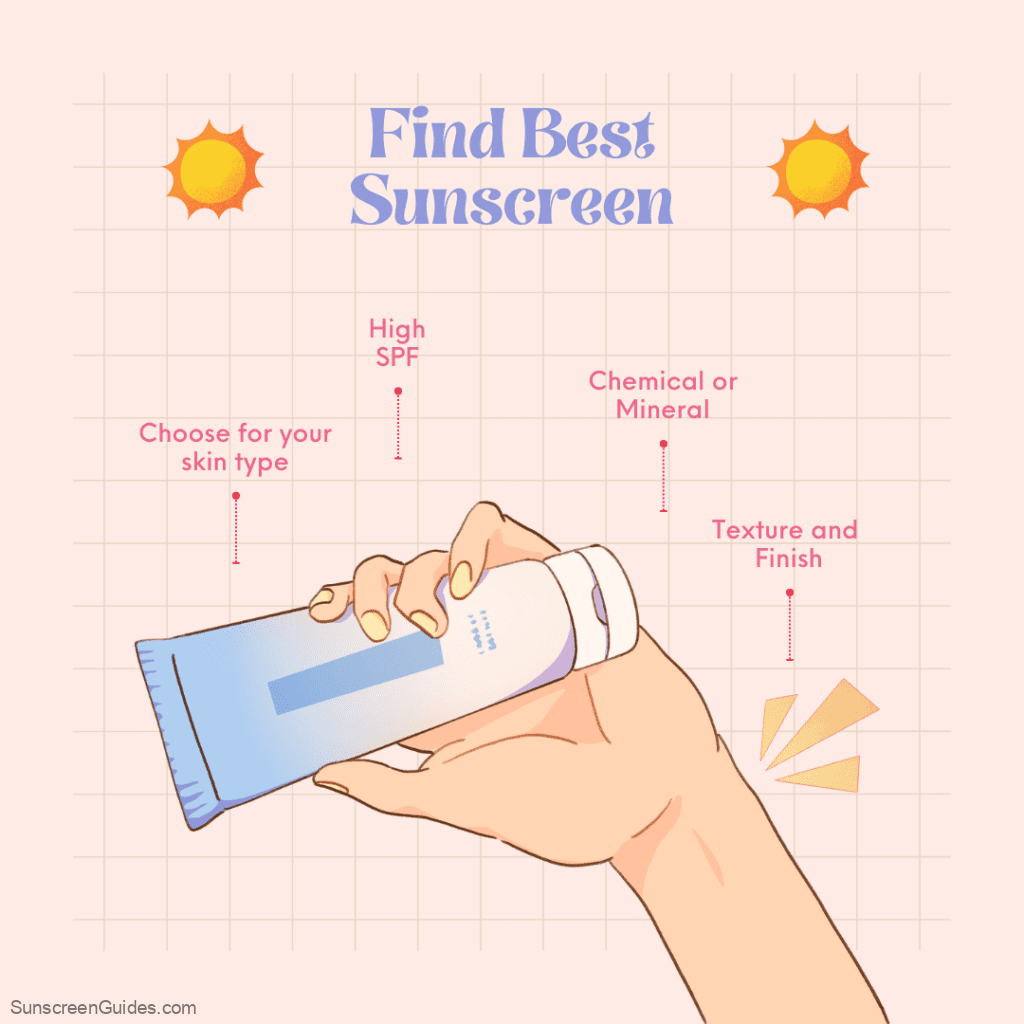
Assessing Your Skin Type: The Sunscreen Compatibility Test
Before diving into the vast sea of sunscreens, it’s essential to understand your skin type. Are you an oily adventurer, a dry-skinned mermaid, or perhaps a combination queen? Knowing your skin type will help you narrow down the options, find your perfect sunscreen guide and find a sunscreen that harmonizes with your unique needs.
- Oily Skin: If your skin tends to be on the oilier side, look for lightweight, oil-free sunscreens or those labeled as “matte finish.” These formulations will provide protection without adding extra shine or clogging your pores.
- Dry Skin: Dry-skinned beauties, rejoice! Seek sunscreens that offer added hydration, such as those with moisturizing ingredients like hyaluronic acid or glycerin. Creamy or lotion-based sunscreens work wonders in keeping your skin nourished and protected.
- Combination Skin: Balancing act, anyone? For those with combination skin, opt for lightweight formulas that won’t exacerbate oiliness in the T-zone while still providing enough hydration for drier areas. Gel-based or gel-cream sunscreens are often a great match.
Embracing the SPF Spectrum: From Low to High, Finding Your Comfort Zone
Now that you know your skin type, it’s time to dive into the realm of SPF numbers. Don’t worry, we won’t get caught up in the SPF number frenzy. Instead, let’s focus on finding your SPF comfort zone.
- Everyday Protection: If you’re mainly indoors or have minimal sun exposure, an SPF 15 to 30 sunscreen might be your go-to. This range offers a good baseline of protection for everyday activities.
- Moderate Sun Exposure: If you’re planning a day at the beach, a hike, or any outdoor adventure, amp up your protection with an SPF 30 to 50 sunscreen. This range is ideal for moderate sun exposure and longer periods spent outdoors.
- Intense Sun Exposure: Are you planning a tropical getaway or embarking on a sun-soaked escapade? Look for sunscreens with an SPF of 50 or higher. These sunscreens provide extra protection for prolonged and intense sun exposure.
Remember, regardless of the SPF number, reapplication is key at sunscreen guide, especially after sweating, swimming, or towel-drying. Don’t let the numbers fool you into complacency.
Chemical or Mineral: Picking Your Sunscreen Warriors
Now let’s talk about the different types of sunscreen ingredients: chemical and mineral. Understanding their differences will help you make an informed decision at your sunscreen guide based on your preferences and skin’s compatibility.
- Chemical Sunscreens: These sunscreens contain organic compounds that absorb UV rays and convert them into heat, dissipating the energy from your skin. They often come in lightweight formulations that are easy to blend. If you prefer a thin, almost weightless feel on your skin, chemical sunscreens may be your cup of tea.
- Mineral Sunscreens: Mineral sunscreens, on the other hand, use active ingredients like zinc oxide or titanium dioxide to create a physical barrier that reflects and scatters UV rays away from your skin. They are often well-tolerated by sensitive skin types and provide immediate protection upon application. Mineral sunscreens are great if you’re seeking a gentle, more natural option.
Texture and Finish: Finding Your Sunscreen Soul Mate
Now that we’ve covered the basics, let’s explore the world of textures and finishes. Your sunscreen soul mate should not only protect you but also feel delightful on your skin.
- Lotion: Classic and reliable, lotion-based sunscreens are easy to apply and provide a smooth, moisturizing feel. They are versatile and work well for most skin types.
- Gel: Lightweight and refreshing, gel-based sunscreens are perfect for those who crave a cooling sensation and a non-greasy finish. They absorb quickly into the skin, making them ideal for oily or combination skin.
- Spray: Ah, the convenience of spray sunscreens! They offer easy application, especially for hard-to-reach areas or for reapplying on the go. Just make sure to rub them in for even coverage.
- Tinted: If you’re a fan of multi-tasking products, tinted sunscreens are your best friend. They provide sun protection while evening out your skin tone, giving you a natural-looking glow.
4) Common Sunscreen Myths Debunked (Prepare to be Amazed!)
Did you know that some sunscreens have magical powers to repel unicorns? Okay, maybe not, but there are plenty of misconceptions floating around the realm of sunscreen guide. In this section, we’ll debunk those myths like a mythical creature hunter. Get ready to have your mind blown as we separate sunscreen fact from fiction and equip you with the truth behind those captivating tales.
Myth 1: “I Only Need Sunscreen on Sunny Days”
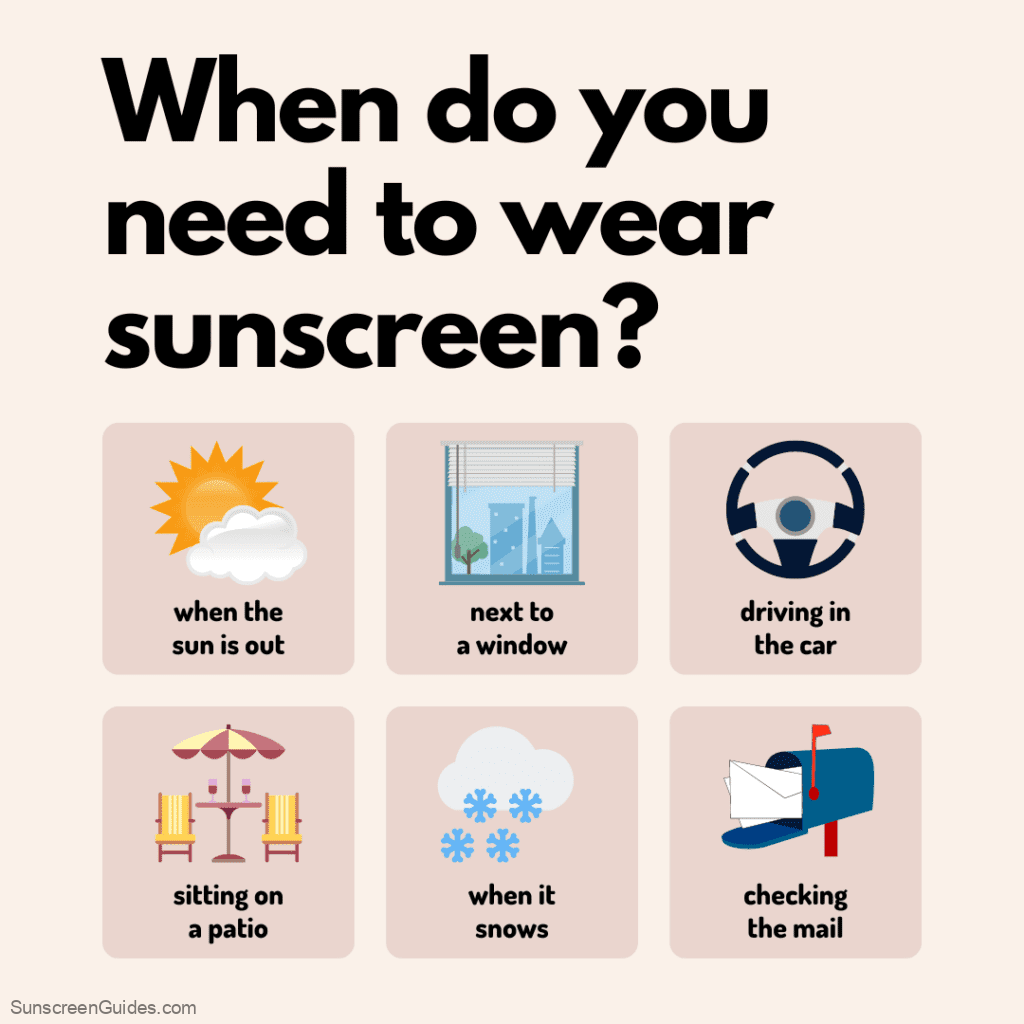
Ah, the classic misconception that sunscreen is only necessary on bright, sunny days. But here’s the truth: the sun’s harmful UV rays are present even on cloudy or overcast days. Up to 80% of the sun’s rays can penetrate through clouds, reaching your skin and causing damage. So, remember, whether it’s sunny, cloudy, or raining cats and dogs, sunscreen is your faithful companion.
Myth 2: “I Don’t Need Sunscreen If I Have Dark Skin”
This myth couldn’t be farther from the truth. While it’s true that darker skin tones have more melanin, which provides some natural protection against UV rays, it doesn’t make you invincible to sun damage. Darker skin is still susceptible to sunburns, skin aging, and even skin cancer. No matter your skin tone, slather on that sunscreen and rock your beautiful melanin with pride. So learn your sunscreen guide.
Myth 3: “Sunscreen Blocks Vitamin D Absorption”
Ah, the eternal battle between sunscreen and vitamin D. But fear not, my sun-loving friends, for you can have both! While sunscreen guide helps protect your skin from harmful UV rays, it doesn’t completely block the absorption of vitamin D. Studies show that even with sunscreen on, your body can still produce vitamin D from sun exposure. So, lather up with sunscreen and soak in those vitamin D benefits responsibly.
Myth 4: “Sunscreen Is Only for the Beach or Pool”
Oh, how we love to frolic in the sun-kissed waves, but don’t limit your sunscreen guide use to beach or pool days alone. The truth is, sunscreen should be a daily staple in your skincare routine. UV rays can reach your skin even during everyday activities like walking, driving, or sitting by a sunny window. Make sunscreen a habit, just like brushing your teeth or putting on your favorite moisturizer.
Myth 5: “Higher SPF Means All-Day Protection”
Ah, the allure of a high SPF number. But here’s the reality: no sunscreen (or sunscreen guide), regardless of its SPF, provides all-day protection. The effectiveness of sunscreen diminishes over time, especially with activities like sweating, swimming, or rubbing your skin with a towel. That’s why it’s crucial to reapply sunscreen every two hours or as directed on the label. Don’t let the high SPF fool you into a false sense of security.
Conclusion
Congratulations, my sun-worshipping comrades! You’ve completed Sunscreen 101 and/or Sunscreen Guide, the crash course in sun protection wizardry. Armed with this newfound knowledge, you’ll confidently navigate the vast sea of sunscreens and emerge victorious against the sun’s relentless heat. So go forth, bask in the sunshine, and remember to slather on that SPF like it’s the elixir of youth. Stay fabulous, stay sun-safe, and let your radiant skin be the envy of the kingdom!
Notes:
You can check American Academy of Dermatology Association FAQ to learn more about sunscreens and sun protection: https://www.aad.org/media/stats-sunscreen
And you can check skin cancer foundation sun protection guide here: https://www.skincancer.org/skin-cancer-prevention/sun-protection/
